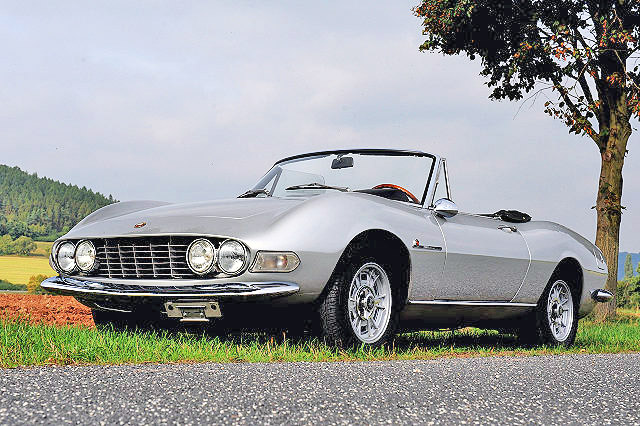In the mid-1960s, Ferrari faced a problem: in order to be able to compete with its single-seater Dino 166 in Formula 2, it was necessary to homologate a new engine. Changes in the FIA regulations stipulated that an engine with a displacement of 1.6 liters and a maximum of six cylinders must be used. This alone would not have been a problem for the Scuderia, as it had a suitable engine on hand with the Dino V6. The engine was named after the nickname of Enzo Ferrari's son Alfredo Ferrari. The young engineer was involved significantly in the development of the engine, but he died far too young at the age of only 24 from muscular atrophy.
The engine alone was not the problem, because the FIA regulations also stipulated that the engine block must come from a production car that had been sold at least 500 times within a year. For the then still small sports car manufacturer from Maranello, this was an almost insurmountable task. It would never have been possible to build and sell 500 cars alone in that time. In order to still achieve the goal of participating in Formula 2, Ferrari decided on extensive cooperation with the Turin-based carmaker Fiat.
Cooperation: Fiat builds Dino Spider and Coupe with Ferrari engine
Fiat CEO Gianni Agnelli, who was known as a good friend of Ferrari's, personally decided to use the V6 engine in his own production car. One became two in the end: the Dino Spider and the Dino Coupe. Fiat commissioned no less than the Turin-based coachwork builder Sergio Pininfarina with the design of the Spider. The Coupe, on the other hand, was created by competitor Bertone. Parallel to the design, Fiat took care to make the Scuderia's purebred sports car engine suitable for everyday use. This task was taken over by engine designer Aurelio Lampredi, who had already worked for the Scuderia before. He simplified, among other things, the chain drive of the camshafts and the valve clearance adjustment.
1966: The Dino Spider is presented to the world public
Already in 1966, Fiat was able to present the Dino Spider at the Turin Motor Show. The curvy design of the 4.10-meter-long convertible was well received, and the performance data of the often called "Ferrari for everyone" car were also impressive: after the revision by Lampredi, the six-cylinder V-engine produced an impressive 160 hp at 7200 rpm and reached a top speed of 210 km/h. Impressive values for the time. Meanwhile, Ferrari also brought the Dino 206 GT, also designed by Pininfarina, onto the market. The car was built around the same engine as the Dino Spider from Fiat, but the manufacturer from Maranello claimed a power output of 180 hp. However, it is more likely that the performance of the two engines produced on the same production line was the same.
1969: Production of the 2400 model switches from Fiat to Ferrari
Ferrari was able to achieve homologation thanks to the Dino Spider and Coupe built by Fiat. Both vehicles sold well. In 1969, a revision was due, which included a more powerful engine, among other things. This coincided with a transfer of production from Fiat in Turin to Ferrari in Maranello for the Spider and Coupe. The new engine now had 2.4 liters, was made of inexpensive cast iron instead of aluminum casting, and produced 180 hp at 6600 rpm. At the same time, Ferrari continued to develop its 206 GT and introduced the revised 246 GT.
Dino Spider 2400 offers more power and better handling
The Dino Spider 2400 not only offered more power, but also better handling. Because previously, like many Ferraris at that time, the Spider equipped with a solid rear axle quickly became loose at the rear when braking. This led to dangerous situations where the Spider was difficult to control. The new independent suspension, which came from the Fiat 130, was supposed to change that. At the same time, the convertible and the coupe received Girling brakes (also used by De Tomaso and Lamborghini) and a manual 5-speed gearbox from ZF, which was also used by Aston Martin.
1972: Ferrari discontinues production of the Spider
The 2400 model did not achieve the commercial success of the first series. One reason was certainly the price, which at 20.000 DM was anything but a bargain for the time. In 1972, Ferrari finally discontinued production after only 424 units were built. The small number of vehicles produced has made the convertible a highly sought-after collector's item, which fetches top prices at auctions. On the classic car market, well-preserved cars can hardly be found for less than 150.000 euros. Prices for first-class examples have even reached 200.000 euros. This puts the prices significantly above those of the more commonly sold coupe, which can be found in good condition for around 40.000 euros.
If you are lucky and do not shy away from restoration, you can also go for a less well-preserved example. The good supply of spare parts for the classic car makes it possible to turn even vehicles in poor condition into real treasures and either drive them yourself or sell them profitably.

